Jack Dorsey: The enigmatic CEO who could save — or break — Western democracy
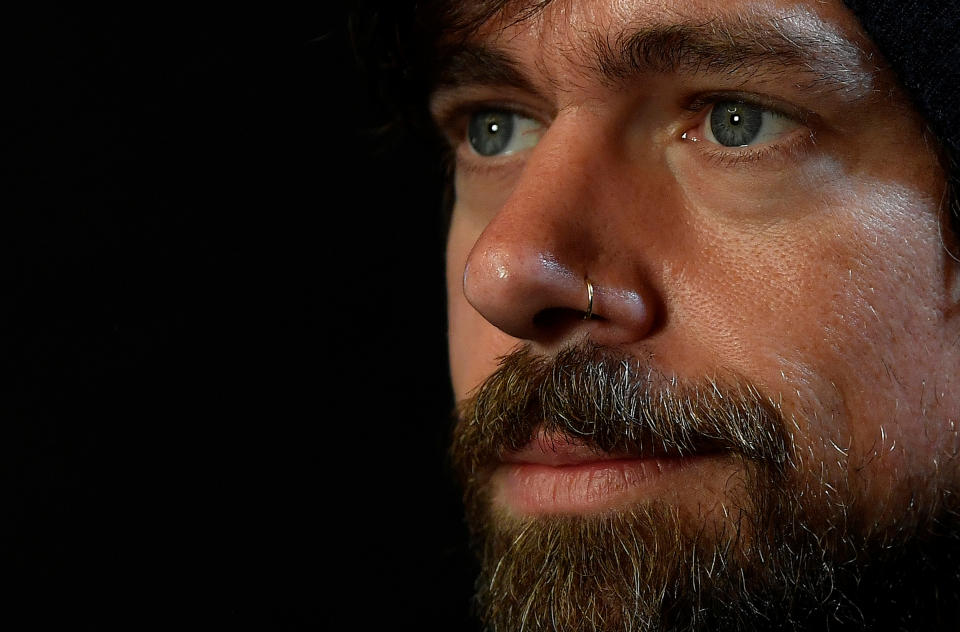
“Jack is thinking about things at a different pace from the rest of us,” says Greg Kidd, who has known Jack Dorsey, now 42, since Dorsey was 19. “Jack’s pace is slower.”
It’s an odd thing to say about one of the only two men in history to have ever simultaneously run two multibillion-dollar companies that he cofounded. But Kidd, who was an angel investor in Dorsey’s first business, Twitter (TWTR), and one of the earliest advisers on the second, Square (SQ), means the remark as high praise.
“Jack’s at a slower pace where he’s noticing things that the rest of us don’t notice,” he explains. “That’s extremely valuable to society. It’s like a Forrest Gump thing.”
Dorsey’s pace of thinking has become an important issue both within his companies and outside of them. Some of those who have worked for him, for instance, complain about how hard it was to compete with companies run by faster moving, ruthlessly aggressive CEOs, like Facebook’s (FB) Mark Zuckerberg or Alphabet’s (GOOG, GOOGL) Larry Page.
“[Dorsey] almost avoids decision-making,” says one former Twitter official in an interview.
“He can’t decide anything,” gripes another.
For perhaps related reasons, Dorsey is also an extraordinarily hands-off manager.
“He once said he thought the perfect meeting was one in which he doesn’t have to say a thing,” recalls a former high-level Square employee. This source described his former boss as “oracular,” “sphinx-like,” “introverted,” and “conflict averse.” Another Square alum characterizes Dorsey’s unwillingness to resolve disputes among managers as almost “Darwinian.”
“He speaks in riddles,” says one former Twitter staffer, while another says his pronouncements could be so long on metaphor and short on specifics that “it was like listening to a fortune-cookie talk.”
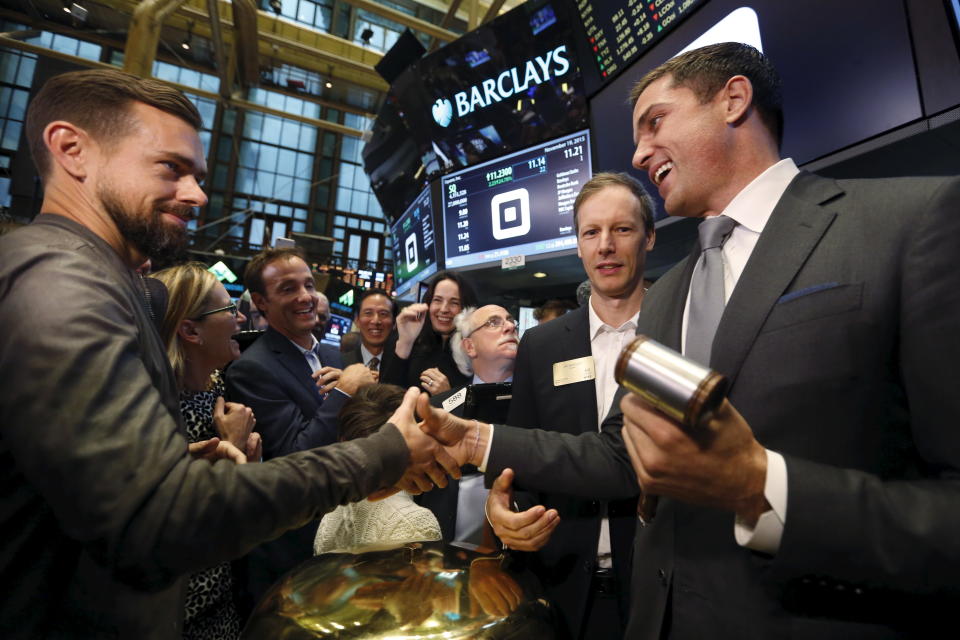
Yet despite all this, his companies are doing well. Square’s stock is up nearly 700% from its 2015 IPO price (even after a sharp drop last week, on disappointing third-quarter earnings forecasts), while shares in the long-struggling Twitter have been staging a turnaround, climbing 190% since spring 2017.
These days, the most urgent complaints about Dorsey’s pace of thinking come from outside his companies. They emanate from people who — especially since the 2016 presidential elections — fear that Twitter has become a threat to Western democracy and culture. It is coarsening and polarizing discourse, they contend, by failing to adequately patrol the platform to combat harassment, hate speech, “dehumanizing speech,” lies, manipulated videos, and political disinformation campaigns — foreign and domestic.
In a way that is disarming at first but, over time, maddening, Dorsey readily pleads guilty to, and apologizes for, all these problems. “The service does, in degrees, incentivize echo chambers,” he conceded to Boston sports analyst Bill Simmons in a podcast in January. “We definitely help divide people,” he admitted to Rolling Stone’s Brian Hiatt in an interview published that same month. “We incentivize a lot of outrage and hot takes,” he confessed to mixed-martial-arts color commentator Joe Rogan in a podcast in February. “I don’t feel personally good about that.”
In the last couple years, Twitter has stepped up its use of machine learning to combat both political disinformation and concerted harassment campaigns. It claimed an 18% drop in reports of “spammy or suspicious” behavior on the site in its second-quarter shareholder letter in July.
“They have taken material steps to make some of the most blatant types of manipulation harder to execute,” says Renee DiResta, of the Stanford Internet Observatory, though she adds that “there’s still a long way to go.”
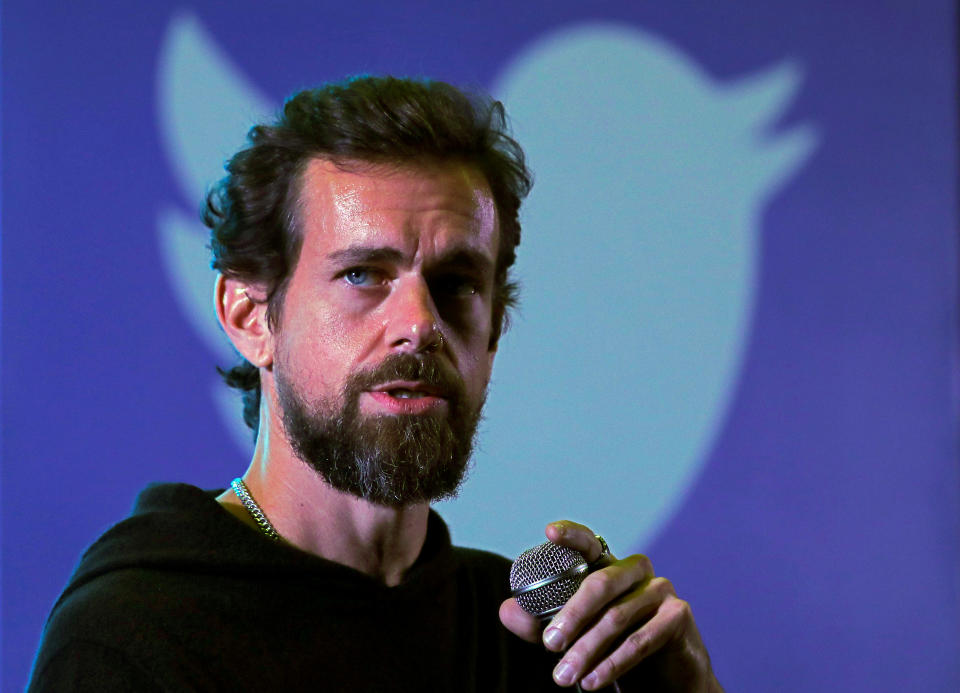
But Dorsey’s timeline for further improvement is vague and his pathway opaque. Dorsey has said that he is pursuing a long-term research project, assisted by the MIT Media Lab and the nonprofit Cortico, aimed at developing a “metric” to measure “healthy conversations” on the platform. But there’s no ETA yet for any findings.
“We’re super early” in the process, he acknowledged to vegan ultra-endurance athlete Rich Roll in a two-and-a-half-hour podcast in February.
“It’s not going to be nine months,” he told Simmons. “It’s not going to be a year.”
Once he has that metric, it’s not clear what he’ll do with it. He claims he might change the “incentives” on the site — maybe even doing away with the chief opiates of social-media addictiveness, like listings of the number of “followers” a user has accumulated. But this could only happen over his investors’ dead bodies.
‘Misinformation is not a solvable problem’
This article is a profile of Dorsey, the astonishingly gifted, driven, and “super weird and strange” guy, as he has put it, whose actions — and inactions — may determine the fate of the free world. Dorsey declined to be interviewed, or to facilitate any interviews with family, friends, or colleagues. Several current and former employees, who expressed initial willingness to speak, later went mute. A Square representative met with me off-site but, in the end, provided next to no assistance. A Twitter representative’s three email responses were even stingier, with the first two clocking in at well under 140 characters.
This article is based on original interviews with more than 20 people who know him from different phases of his life, including 16 who worked with him at either Twitter or Square. For Dorsey’s perspectives, I have drawn from the many hours of Q&A-style video and audio interviews and talks he has given over the years at tech conferences, Stanford, Oxford, TED, the Global Hope Forum in May, and other settings. These include 14.5 hours of podcast interviews he sat for between January and March of this year. I have also drawn on his own tweets, extending back 13 years, as well as media profiles and a 2013 book, Nick Bilton’s “Hatching Twitter,” with which he cooperated during the early years of Square.
For those hoping that Dorsey will one day slash through some Gordian knot and end Twitter’s toxicity — "@Jack, ban the Nazis” has become an internet meme — this portrait will not be reassuring. Bold moves are not his style, and he believes that most of these demands are neither feasible nor desirable.
“We’re not going to solve the lying problem,” he told Simmons in January. “We’ve been lying as humans forever. … Misinformation is not a solvable problem.”
Similarly, censorship will be futile in the long run, he believes. “We’re going to a world, especially with technologies like blockchain, [where] all content that exists that is ever created will exist forever,” he told Rogan in February. “You won’t be able to take it down.”
We’re committing Twitter to help increase the collective health, openness, and civility of public conversation, and to hold ourselves publicly accountable towards progress.
— jack 🌍🌏🌎 (@jack) March 1, 2018
Dorsey’s stance stems from something deeper to his core than respect for freedom of speech. It emanates from his beloved hacker roots, and all that they have taught him. For Dorsey, truths percolate up from the bottom; they aren’t dictated or adjudicated from the top down. His fundamental understanding of what the internet is, and where it is heading, is at odds with critics’ demands for policing of civility and truthfulness.
“I am definitely skeptical of centralized organizations,” he told Rich Roll in March, “including my own — Twitter and Square. … The internet more than anything else has allowed us to remove so many barriers and boundaries [and has offered] the promise of providing at least the framework and infrastructure toward an understanding of one humanity.”
While acknowledging that Twitter reflects both the best and worst in mankind — in fact, because it reflects both — Dorsey harbors a nearly mystical faith in the positive force that Twitter can become for the world.
“What Twitter represents is spiritual to me,” Dorsey continued to Roll. “Tapping into e-consciousness, the larger organism — whether it be the planet, the universe, the social consciousness — is what drives me. There’s a lot of power to seeing how people think in ways that make us feel great, and also things that [make us feel] super-uncomfortable. Because … there’s no other path to evolution and making something better unless we can talk about it.”
Not surprisingly, Dorsey’s longtime friend Kidd thinks Dorsey, despite his eccentricities, is the best guy to rein in the monster he created. “I can’t think of a better person to be agonizing over these issues than Jack,” says Kidd, who is a cofounder of the Hard Yaka investment firm and CEO of globaliD, a portable identity software company. “That’s a leadership issue. Not a management issue.”
Yet with the 2020 elections approaching, others fear Dorsey lacks the needed proactiveness and sense of urgency. TED Talks chief Chris Anderson captured these sentiments in April when he likened the situation to that of passengers aboard a steamship (“the Twittanic,” he called it) bearing down on an iceberg, with Dorsey at the helm. “They say, ‘We’re worried about the iceberg ahead,’” Anderson said to Dorsey during a Q&A. “And you go, ‘You know, that is a powerful point. Our ship frankly hasn’t been built for steering as well as it might.’ But we’re all outside, saying, ‘Jack, turn the f---ing wheel!’”
The audience applauded for 10 seconds.
Dorsey’s flat-affect, monotone response — thoughtful, earnest, but seemingly incapable of conveying exigency — merely reinforced the concerns that sparked the question.
“So we are working as quickly as we can,” Dorsey finally offered, after a 180-word digression into what he found at the company nearly four years earlier when he returned as CEO. “But quickness will not get the job done. It’s focus. It’s prioritization. It’s understanding the fundamentals of the network and building a framework that scales and that’s resilient to change.”
Facebook’s monthly average user numbers dwarf Twitter’s — about 2.4 billion to roughly 330 million. But Twitter’s influence is not captured by those numbers. To begin with, Twitter’s users include the world’s political leaders, thought leaders, and the media. In addition, tweets are screenshotted daily on television and in newspapers, and are viewed on hundreds of thousands of third-party sites and blogs in ways that Twitter can’t count.

Nothing has showcased the strange, unforeseeable, and fearful power of the medium as has the presidency of Donald Trump. At the outset, Trump was elected with the support of 3,841 Twitter accounts controlled by a Kremlin-funded troll farm, as well as 50,258 Russian-controlled automated accounts (bots), by Twitter’s count. (In the face of calls to ban or, at least, label bot accounts, Dorsey is still wrestling with what to do. “So this is a real challenge and something we’re trying to wrap our heads around,” he told Joe Rogan in February. He’s weighing the feasibility of eventually using the touch ID and face ID features now available on smartphones to verify “human” accounts, but there is no timetable.)
Since gaining power, Trump has made Twitter his favored means of communication. He has used it to fire a chief of staff and a Secretary of State; to announce plans to withdraw troops from Syria (before notifying his Secretary of Defense or the ambassadors of allied nations fighting there); and to announce a major policy shift on the census (before notifying the Justice Department lawyers called upon to defend them).
Mike Pompeo, Director of the CIA, will become our new Secretary of State. He will do a fantastic job! Thank you to Rex Tillerson for his service! Gina Haspel will become the new Director of the CIA, and the first woman so chosen. Congratulations to all!
— Donald J. Trump (@realDonaldTrump) March 13, 2018
He has used it to broadcast improbable and likely defamatory attacks on perceived enemies, including former President Barack Obama, former FBI Director James Comey, the FBI generally, Special Counsel Robert Mueller III, and Twitter itself. In June he threatened to “obliterate” parts of Iran via tweet. (Because Trump uses the platform for official business, a federal appeals panel ruled in July that his “blocking” of select followers, who had “replied” critically to his tweets, violates the First Amendment prohibition against government viewpoint discrimination.)
Weirdly, Iran also now issues official state proclamations via Twitter — even though it blocks its own 81 million citizens from accessing the platform. Its foreign minister, Javad Zarif, maintains an account through which, for instance, he recently denied his nation’s involvement in mine attacks on oil tankers, while also belittling U.S. National Security Advisor John Bolton and his staff as the “#B_Team.”
Abuses of the platform have become ingenious and bizarre. Last October, a study in the American Journal of Public Health concluded that bots of unknown origin, together with accounts controlled by the Russian Internet Research Agency — the same troll farm that meddled in the 2016 elections — were sending and amplifying tweets intended to “erode public consensus” in the U.S. about the value of vaccines. In essence, Twitter was being used as an instrument of biological warfare.
I did my meditation at Dhamma Mahim? in Pyin Oo Lwin. This is my room. Basic. During the 10 days: no devices, reading, writing, physical excercise, music, intoxicants, meat, talking, or even eye contact with others. It’s free: everything is given to meditators by charity. pic.twitter.com/OhJqXKInD3
— jack 🌍🌏🌎 (@jack) December 9, 2018
Concerns were raised about whether Dorsey was the right guy to run such a vital communications platform when, last New Year’s Day, he posted a tweet-storm detailing a 10-day vipassana session to which he had treated himself on his birthday in Pyin Oo Lwin, Myanmar. Vipassana is a sort of Ironman meditation ordeal involving physically painful yoga positions and sensory deprivation. “No devices, reading, writing, physical exercise, music, intoxicants, meat, talking, or even eye contact with others,” Dorsey tweeted. (He was widely rebuked for initially making no mention of the Myanmar government’s oppression of the Rohingya Muslim minority.)
The greatest product he ever designed – himself
Similar apprehensions were fanned in March, when Dorsey gave an hour-long interview to Ben Greenfield, a “human body and brain performance coach” in whose work Dorsey was alarmingly well versed. Greenfield’s show is sponsored by Joovv, a company that makes “photobiomodulation” products that emit red or near-infrared light. According to Greenfield, these products enhance skin and thyroid health and reduce inflammation and pain, among other benefits. (The science is sparse.) At the start of the show, Greenfield touted the miniaturized Joovv Go product, noting: “I tuck it between my crotch when I’m reading in bed at night while I travel for increased testosterone.”
To Greenfield, Dorsey detailed his daily regimen of luxe asceticism. He described the near infrared tent (available from SaunaSpace, $5,499) he uses, which is lined with a material that blocks out electromagnetic waves from cellphones and the like. (“It feels a little different because you’re not being hit by all that EMF energy.”) He discussed the cedar tub with a chiller system that he has had installed for his ice-baths, chilled to 37-42 degrees fahrenheit. (“I feel like if I can will myself to do that thing that … hurts so much, I can do nearly anything.”) He mentioned the ōura Ring ($299-$999) he relies on for self-quantification. He described his 22-hour daily fasts (water permitted), topped off, on at least three occasions to that point, with a three-day weekend fast.
A chorus of press sniping followed for months, with The New York Times leading the pack. “Jack Dorsey is Gwyneth Paltrow for Silicon Valley,” its headline ran, while the article dubbed him a “one-man Goop.”
For those who admire Dorsey, however — especially those inured to Silicon Valley longevity and wellness “hacks” — the brouhaha was just silly.
“Let people be,” says Ryan Gilbert of Propel Venture Partners, an early adviser to Square, and a very happy shareholder. “We’ve got so many more important things in this world than to start opining that because a guy has a health regimen that’s different from yours, he shouldn’t be running these businesses.”
Dorsey understands that some people will roll their eyes at the experiments he is constantly running on himself. “It’s so ‘Silicon Valley’ episode,” Dorsey acknowledged to Rich Roll, referencing the HBO comedy series. “I get that. … I don’t care. I get value out of it. I don’t want to be afraid of creating potential for someone else who might be on the edge of doing something like this. … What’s learning unless you share?”
For all of Dorsey’s otherworldliness, eccentricity, and introversion, he is also a salesman. A skilled and relentless one, who understands the primacy of storytelling.
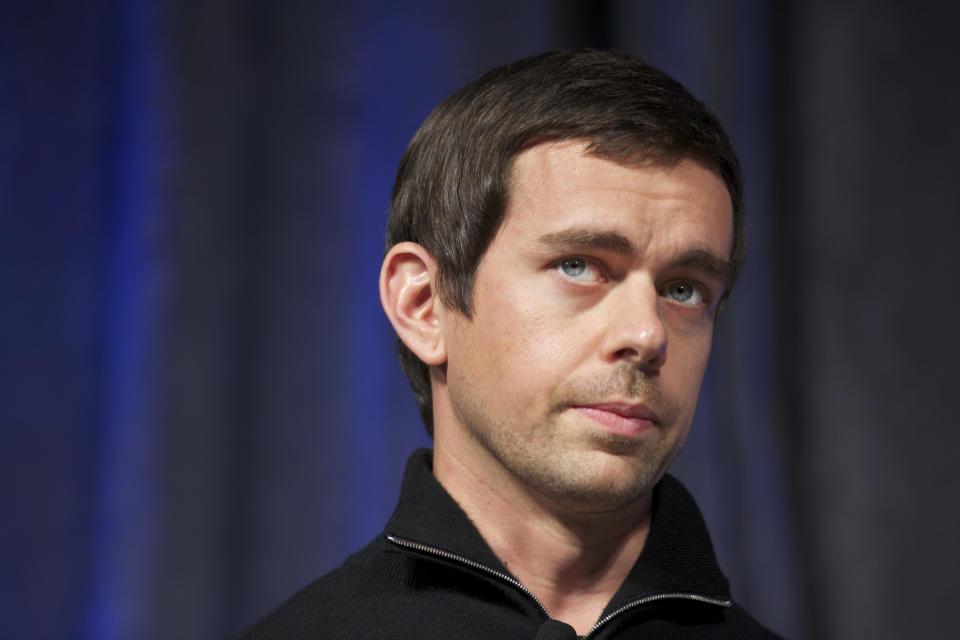
“One of the biggest things that has helped me,” he told an audience of prospective entrepreneurs at Stanford in February 2011, “is learning how to become a better storyteller, and the power of a story.” He was speaking then about launching Square, and how he conveyed to both employees and prospective customers what the company was about.
“We spend a lot of time writing what’s called user narratives,” he continued, explaining how the product could help an individual customer. “It reads like a play. It’s really, really beautiful. And if you do that story well, then all of the prioritization, then all of the product, all of the design, all the coordination you need to do with these products, just falls out naturally. … We want one epic, cohesive story that we tell the world.”
Oft-repeated anecdotes, retold virtually verbatim — about his upbringing, his life, his companies — pervade Dorsey’s talks and interviews. I do not doubt their essential truth, and in many cases they are at least partially corroborated. But they are clearly told with conscious intent.
“He is hyperconscious and sensitive about his public image,” says the former high-level Square staffer. “As someone once said: The greatest product he ever designed is Jack Dorsey.”
With that proviso, here is Dorsey’s story.
‘He was always a minimalist’
He was born in St. Louis in November 1976. He spent most of his childhood, he stresses, within the city limits — i.e., not a suburb. (His family actually did move to Boulder, Colo., for several years, but returned to St. Louis in time for Jack to attend high school there. Dorsey rarely mentions the Boulder years.)
While he was growing up, his mother, Marcia, was a Democrat and his father, Tim, a Republican. Marcia is artistic — she likes to draw — while Tim is a technologist. (Tim still runs a company that services and refurbishes mass spectrometers.)
Neither of Jack’s parents graduated from college. They were devout Catholics. At his choice, Dorsey has said, he was the only one in his family who was never confirmed. “I get my sense of spirituality through connection,” he told Rich Roll in March — adding then that “what Twitter represents is spiritual to me.”
Dorsey often recounts how his parents met in what he calls his own “founding story.” In the mid-1970s, Tim Dorsey and his best friend opened a pizza restaurant named Two Nice Guys. “They made one rule,” as Dorsey related it at a TechCrunch Disrupt keynote in 2012: “They would not date the wait staff. And the first person they hired was my mother, and I was born 10 months later.”
Dorsey has two younger brothers, one of whom now works with his father. Dorsey’s mother, Marcia, recalled to New Yorker writer D.T. Max, for a 2013 profile, that when the family would move into a new home, Jack always chose the smallest room. “He was always a minimalist,” she told Max. (Jack recently explained his lifelong attraction to minimalism in these terms: “I want to figure out how to unlock everything I’m born with, because I know that’s all I need. I don’t need any of these objects, any of these technologies. … I think of most technologies as a crutch to point back to what we’re inherently capable of.”)
Dorsey remains close to his parents, and they sometimes visit his companies or come see him when he’s speaking anywhere remotely near St. Louis — like Detroit. Those who like him cite his strong relationship with his parents as evidence of his solid, Midwestern values.
Good Morning! ??
— Marcia Dorsey🌻 (@marciadorsey) August 7, 2019
He begins every day by texting his mother, he told Vanity Fair in 2011. Asked recently by podcaster Simmons to name his favorite “follows,” he gave his mother as his first choice. “Every morning she says ‘Good morning,’” he said. “And every evening she says ‘Good night,’ usually with a sunset picture.” (Dorsey’s second choice was a bit of a statement — a way of thumbing his nose at conventional wisdom. He named Tesla (TSLA) and SpaceX founder and CEO Elon Musk — the only other CEO running two multibillion-dollar companies that he founded. Musk had, just four months earlier, settled charges with the Securities and Exchange Commission stemming from a tweet in which he had falsely claimed to have secured funding for Tesla to go public at $420 per share. “He really gets it,” Dorsey said of Musk, praising his spontaneity on the platform.)
Am considering taking Tesla private at $420. Funding secured.
— e^👁🥧 (@elonmusk) August 7, 2018
When Dorsey was 4 to 7 years old, he suffered from a severe speech impediment. This made him cripplingly shy, even with members of his own family. But when he reached about fifth grade, he consciously decided that he could not live that way. He took two years of speech therapy and then proceeded to push himself to master the most daunting challenges he could imagine, including debate club and even an improv class.
In 1984, when Dorsey was about 8, his father brought home the family’s first computer, an IBM PC Junior. Later, they got a Macintosh. By the time he was 11, he had become fascinated by the internet, taught himself to code, and become part of the city’s vibrant hacker culture. (He also began reading about cryptography, according to an interview in February with Stephan Livera, who podcasts about bitcoin. Dorsey has become a zealous champion of bitcoin — perhaps his most intense enthusiasm of the moment. Since January 2018, Square has permitted consumers to buy and sell bitcoin using its Cash App product, and this year it began hiring cryptocurrency specialists who will report to Dorsey personally and donate all their work on an open source basis to the crypto community.)
As a teenager, Dorsey became “obsessed” with maps — especially maps of St. Louis and New York City — which he taped on the walls of his bedroom. (“Life really happens at intersections,” he said at a 2012 TechCrunch keynote.)
Listening to his father’s CB and police scanner, he liked to follow the status reports radioed in by police, fire trucks, and ambulances to their dispatchers. At first he plotted the vehicles’ movements on paper, but by the time he was 14 he had taught himself to make maps on the computer. “I learned how to draw dots, how to move them around, and then how to constrain them within the streets,” he recounted at a Stanford Graduate Business School event in 2013. (He used nearly identical language at an earlier Stanford event in 2009, to Kara Swisher at an All Things D conference in 2011, and at Oxford in 2014.) “And then I would listen to these ambulances and [someone would say]: ‘I’m at Fifth and Broadway. I’m going to St. John’s Mercy. I have a patient in cardiac arrest.’ So I’d type that into my program, and I could see the dot move ... So suddenly I had this picture of what the city was doing.”
In recounting these stories, Dorsey usually adds words to the effect: “I’ve never really had a desire to become an engineer or to be a CEO or to start a company or be an entrepreneur,” as he put it at Oxford. “I learned whatever it took to move me to [the] next step.” (At the same time, Dorsey did show some precocious interest in business. When he was 10, he proudly presented his uncle with a business card reading “Jack P. Dorsey, Consultant,” his uncle recounted to the St. Louis Dispatch in 2009.)

When Dorsey was 15, his mother ran a small coffee shop in the city. One day Marcia overheard a customer saying he needed some coding help, so she volunteered Jack’s services. The customer, Jim McKelvey, ran a digital publishing business. Jack went over to McKelvey’s offices. McKelvey was in the middle of something, and told him to wait.
“I turned back to my computer,” McKelvey later recounted to Mashable, “and I forgot about him. He stood motionless for an hour in the same position.” But Jack “pulled an all-nighter” working for him that same night, McKelvey added.
Three of Dorsey’s friends from Bishop DuBourg High School told me they had no knowledge of Dorsey’s map obsession, though they say it sounds in character. They knew that he was into computers, and remember him running a football pool with one. He was very “quiet,” but not necessarily “shy,” they say. Dorsey presented a daily, closed-circuit TV “news” program at the high school, Charlie Kelly remembers.
Another friend, Tim Brouk, remembers Dorsey’s father taking them to the Hi-Fi Fo-Fum electronics store one day. He still remembers how “super into it” both Jack and his father were. Jack seemed fascinated by a wide range of electronics, including MIDIs — musical instrument digital interfaces that connect computers to synthesizers and samplers, he recounts.
In fact, these friends mainly remember Dorsey for introducing them to “super cool” music. He also initiated them into “all ages” venues in the city, where kids below drinking age could legally attend live performances — though their curfews sometimes forced them to leave before the headliner played. Brouk remembers Dorsey turning him on to Operation Ivy in particular, a Berkeley ska-punk band. (Today, Dorsey still frequently tweets out favored musical tracks across a very broad range of genres.) Dorsey has also often praised a French Internet radio station, FIPradio, which he has called “the best radio in the world.”)
Upon graduation in 1995, Dorsey went to what was then called the University of Missouri at Rolla, an engineering school a couple hours southwest of St. Louis. (Years later, in 2009, when Dorsey was becoming famous because of Twitter, the St. Louis Dispatch contacted the university to get his professors’ memories of him. Anticipating such calls, the school had asked Dorsey to identify the professors who knew him best, and Dorsey had given them two names. “Neither of the two he selected could remember him,” however, the school told the paper.)
Jack Dorsey meets a ‘kindred soul’
Dorsey’s interest in “dispatch” — monitoring messengers and police cars and so on — persisted. He learned about a company in New York called Dispatch Management Services Corp. (DMS), which would soon go public. He hacked into its website, contacted its chairman, explained the software vulnerability, and asked for a job.
DMS’s chairman was Greg Kidd. Kidd had come to dispatch circuitously. After graduating from Brown, he had become an instructor for Outward Bound; had competed as a Pro-Am bike racer; had graduated from the Yale School of Management; and had then logged in six years with Booz Allen, including work on financial services in the U.S. and Australasia. Since couriers deliver checks, he became involved in optimizing courier routes. He and some partners then built dispatch software, based on a novel auction marketplace concept he’d first encountered in New Zealand, and then expanded worldwide under the DMS banner.
From their first conversations, Kidd says, it became clear that Jack was “a kindred soul.” “It wasn’t so much that [Dorsey] was a hacker,” he explains. “That just told me he could code. The real point is that someone else was interested in dispatch. That’s a fairly narrow field. It was clear he’d thought about it. And he was thoughtful about it.”
Dorsey transferred to New York University so he could do consulting work for DMS. In 1998, however, Kidd had a disagreement with his board and quit. Though Dorsey was still a semester shy of graduation, he and Dorsey moved to San Francisco, where Kidd founded a web-based dispatch company, called dNET, with Dorsey helping build the initial service. Kidd envisioned a company something like what Grubhub or Postmates have become today, he says.
When Dorsey arrived in the Bay Area in 1999, he would sometimes work the door at a Berkeley all-ages venue, he told Rolling Stone’s Hiatt in January. There, Dorsey remembers marveling at how the young bands could progress from “absolutely terrible” to “terrific” within weeks. “I’m fascinated by this concept of working in public and allowing people to see you get better and better as time goes on,” he told Hiatt.
It’s a theme Dorsey returns to often. It describes, of course, exactly what Dorsey later had to do in the course of learning to be a CEO — a position he first assumed at Twitter at age 30. Given journalists’ intense preoccupation with Twitter — a tool that quickly became indispensable to them in covering their beats, distributing their work, and measuring their success — few CEOs have ever had to learn the ropes under a brighter spotlight.
Last October, for instance, when Square CFO Sarah Friar left to become CEO of Nextdoor, Dorsey, as a fond farewell gesture, wrote her a letter of advice, which she posted in its entirety in a tweet. Dorsey’s point number one: “Allow yourself to fail in public. . . . Risk, creativity, and defining your own path is made possible only through a series of failures, some big, some small. Hide none of them. Show all of them!”
1/ Thank you @jack for these words of wisdom. Posting because these should go broader than just me. pic.twitter.com/5PwduF92sm
— Sarah Friar (@thefriley) October 13, 2018
Another variation on that theme surfaced a few months later. Podcaster Simmons asked Dorsey what his favorite “Blank Twitter” was. Simmons was alluding to the many de facto Twitter neighborhoods, based on user affinity or interest, like #NBATwitter; #MMATwitter (mixed martial arts); #BlackTwitter; and #hftwitter (high fashion). Dorsey chose #NBATwitter — but for a revealing reason. It was his favorite, he said, because the players are so “exposed.” He elaborated: “They live so much of their lives in public. They’re wearing shorts and tank tops. The fans are literally right next to where they’re playing. … This concept of living in public. Of working in public. .... It just makes me feel closer to them.”
When he got to San Francisco in 1999, Dorsey was wearing dreadlocks, according to the New Yorker’s Max, which he sometimes dyed blue or orange. He wore a slender nose ring, too.
Dorsey’s constantly shifting fashion tastes are, like his diet and wellness regimes, different manifestations of the constant experiments he runs on himself, which he calls “tinkering.” (“I want to consistently experiment with myself so I always improve,” he tweeted in April 2018. “No fixed mindset.”)
In July 2000, Dorsey wrote a software program called Stat.us, he has often said. The program he wrote six years before Twitter was inspired by both LiveJournal, an online blogging service he had started using, and AOL Instant Messenger, which permitted users to leave short automated messages to say that they were away from their keyboards — and, if they wanted, to explain why. Unlike these forebears, though, Dorsey’s software would let people report their status from a phone as they walked about town. He had acquired an early Blackberry, called a RIM 850, which had email capability. Using his software, he could email out status updates — much as the ambulances used to, as he listened to them on his dad’s police scanner. His emails would go to anyone who signed up to receive them. He sent one saying, “I’m in the Bison Paddock [in Golden Gate Park] watching the bison.”
“I quickly learned that, first, no one else had a mobile email device, so the system was kind of useless,” he later told Techonomy founder David Kirkpatrick, for a profile for Vanity Fair. “And secondly, no one really cared what I was doing in the park.” He shelved the idea, but kept thinking about it. (Six years later he posted a sketch on Flickr, which he said was a prototype of Stat.us that he’d set down in a notebook.)
Around the time Dorsey was composing Stat.us, the dotcom crash was vaporizing hundreds of internet startups. Kidd’s dNET became one of those, putting Kidd and Dorsey out of work.
Kidd went to Washington, D.C., where he spent a couple years working in the payments division of the Federal Reserve Board. He stayed in touch with Dorsey, though, who had followed girlfriends to Richmond, Virginia, and, later, Cambridge, according to Bilton’s book.
In 2003, Kidd recalls, Kidd was weighing whether to propose to his own girlfriend, Amita. He asked Dorsey for his advice. Dorsey wrote back: “I think you should get married. To Amita.”
Dorsey’s thinking is “discrete,” Kidd explains. “Like in small packets. He thought, first, that it was good that I get married. And, secondly, that I shouldn’t confuse that with who to marry”— even though he also approved of Amita. Thinking like that is helpful, Kidd says, if you’re doing things like building software — or companies. Dorsey progresses one step at a time, he says, and knows not to try to do everything at once.
Dorsey went home to St. Louis for a period, where he did some programming projects. After he began to get carpal tunnel, he became interested in curing himself through massage, and became a certified masseuse. He also took drawing classes at the city’s botanical garden. (He liked ferns in particular, he told the New Yorker’s Max. “They’re a single structure that tends to repeat itself,” he said. “They’re fractal.”)
In late 2004 he returned to the Bay Area, where Kidd had also returned. Dorsey began staying in a shed in Kidd’s backyard in Rockridge, in the East Bay. He helped out with the Kidds’ newborn daughter.
“Jack is terrific with kids,” Kidd says. “He’s a good listener. Good observer. Very patient. His emotional IQ is very high even though, because of his demeanor, people aren’t sure whether he’s really present.” By demeanor, Kidd explains, he means that “Jack is a man of few, but powerful, words.”
During these years Dorsey took some courses in figure drawing and in fashion design, according to both the New Yorker’s Max and author Bilton. He had become especially enamored of the work of Scott Morrison, who designed jeans for the Earnest Sewn and, later, 3x1 labels. He would later tweet encomiums to Morrison’s jeans over a period of about seven years. (Denim has held a longtime fascination for Dorsey. He called it “a natural journal that you wear,” in a talk to Stanford business students in 2014. He was referring to the way that if someone puts a phone in his back pocket, it makes an imprint. Denim shows how wearers “live, move, and what they do with their lives.”)
Dorsey acquired a prominent tattoo on his left forearm during this time period. It’s a thick, nine-inch, S-shaped thing. In 2011 he told Kirkpatrick, for Vanity Fair, that it represents the integral sign in calculus, the f-holes on a violin (Dorsey once played one as a kid), and the human clavicle (“the most graceful bone in the body”).
Dorsey later told Bilton the same, but added an intriguing twist. The S-shaped tattoo actually covered up an earlier one: “Odaemon!?” The exclamation mark symbolized Dorsey’s excitement for life; the question mark, his curiosity; while “daemon,” Bilton explained, referred to “a computer program that lives in the background.” Dorsey saw himself as a person who lived “behind the curtain.”
Given how public Dorsey’s life would later become after Twitter’s launch, these might seem like youthful sentiments that were later discarded. But in his interview with Rolling Stone earlier this year, Dorsey returned to the same theme. He said that his favorite character from the Wizard of Oz was the wizard, because “he was behind the curtain” and “I love being behind the scenes.” But it’s an eccentric interpretation of that character. The wizard’s actions were highly public; what he did behind the scenes was manipulate his image to appear mightier than he was.
One day, while Dorsey was still living in Kidd’s backyard, Kidd remembers Dorsey talking to him about ants.
“When ants go out, they find things like a picnic basket,” Dorsey told Kidd, as Kidd recalls it. “If it’s full of good stuff, they grab some, and they bring it back. When they walk back they leave pheromones or whatever on their trail — like a scent. If other ants see that you brought back good bounty, they say, ‘I’m going to follow your pheromones. I’ll go get some.’ Those ants come back, and that creates a reinforcing cycle.
“So somebody puts something out there, somebody follows it, people follow the follower, and it just builds up. … So that feedback loop, which is what’s [now] happening at Twitter, was really an insight that he was already seeing with swarms of ants.”
‘TWTTR’ is born
In 2005 Dorsey got a job programming for Odeo, an early podcasting company. It was funded by Ev Williams, who had earlier founded Blogger and then sold it to Google, making a small fortune. Its key software had been written by Noah E. Glass, who was Odeo’s president. (Glass is no relation to Noah H. Glass, who founded and runs Olo, which makes a platform that facilitates digital ordering from restaurants.)
In late 2005, when Apple (AAPL) added a podcasting directory to iTunes, Odeo’s raison d’être vanished. Williams solicited the staff for new ideas. Dorsey proposed a version of his old Stat.us idea, though this time based on SMS messages — i.e., texting — instead of email. A user would text a message to the service’s 5-digit “short code,” and then the system would relay that message, also by text, to all the other users who had indicated that they wanted to receive that person’s messages. The messages would also be archived on the web.
Glass was enthusiastic, and Williams gave the greenlight. Glass chose the name “Twitter,” which conveyed both the notion of light chatter and the physical vibration of a mobile phone alerting in one’s pocket. They originally used the name “twttr,” hoping to use “t-w-t-t-r” as their 5-digit SMS code, according to Bilton. It was already taken, though, so they settled for 4-0-4-0-4.
On March 21, 2006, using a beta version, Dorsey sent out the first tweet: “just setting up my twttr.”
just setting up my twttr
— jack 🌍🌏🌎 (@jack) March 21, 2006
By now, incidentally, Dorsey was fairly clean-cut, though with a shadow around the moustache and chin, and he sometimes wore a nose ring still. He did a little modeling while launching Twitter, posting some examples on his Flickr account. One bears the wry legend: “I wear expensive clothes so you won’t have to.”
When Twitter first went live that July, Williams explained on Odeo’s blog that this side project was mainly the work of Glass, Dorsey, and Florian Weber — a German developer who had been working with Odeo since 2005. Dorsey and Weber wrote the Twitter prototype in two weeks.
Just before launch, in June, Dorsey had actually considered raising the character limit to 900 characters, according to someone who was there at the time (and who provided electronic communications corroborating his account). Some carriers had begun supporting SMS messages of that length, and though Dorsey liked the “shortness” of Twitter’s messages, it seemed “false” to him to impose an arbitrary lower limit.
Weber argued against it, urging that that wasn’t what Twitter was for. Dorsey tabled his notion of raising the limit. Then, in the fall, it was decided to limit tweets to the more common SMS limit of 160 characters, although the username depleted some of the character supply. In January 2007 Dorsey shrunk the limit to 140 characters, excluding username, so there could be a uniform limit for everyone.
By 2007, Williams had bought back Odeo’s stock, and had spun off Twitter as a new company. Though Dorsey was clearly the driving force behind Twitter, the company has become a case study in the murkiness of the term “cofounder.” Glass had been fired during the summer of 2006. (He could not be reached for comment.) Weber quit in February 2007 after a personal falling out with Dorsey, according to a person present at the time.
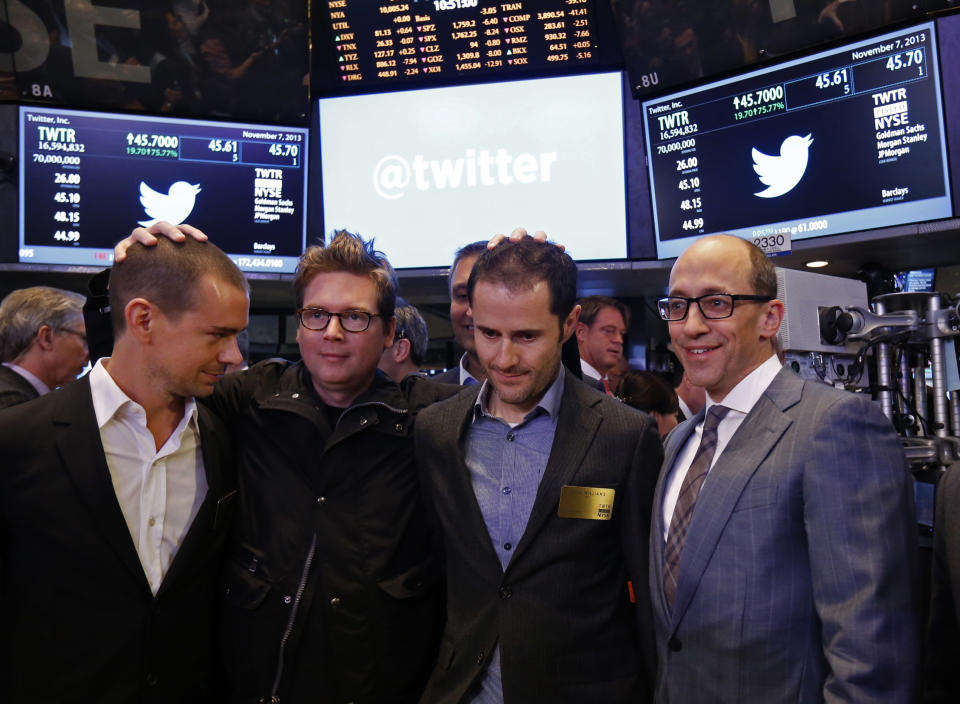
The official co-founders were deemed to be Williams, Dorsey, and Biz Stone, who had been the public face of Odeo and who also, according to Dorsey’s accounts, contributed some product ideas to Twitter. Williams got 70% of the stock; Dorsey, 20%; and Stone and another key early player, Jason Goldman, received 3% each, according to Bilton’s book.
In March 2007, after the Twitter crew showed off their new service at a South by Southwest Conference, it took off contagiously. Over the next four years, while Twitter grew into a household word and multimillion-dollar business, Glass was never mentioned. But his claims to cofoundership were finally championed by Business Insider’s Nicholas Carlson in 2011 and, then, by Bilton in his 2013 book. Williams eventually did give Glass some equity, Glass told BI. (Weber, the German programmer, never got a dime.)
In truth, the service has evolved so greatly since its SMS roots, that assigning “cofounder” labels is challenging. Today, Dorsey often argues that Twitter was largely “discovered,” not invented. What he means is that the product evolved as those running it observed what users were trying to do with it, and then developed features to help them accomplish their goals. For instance, when Twitter noticed that users were jumping through laborious hoops to rebroadcast the most interesting tweets of people they followed, its coders created a “retweet” button to make the operation simple. Similarly, the use of the @ sign, to direct comments to particular individuals, or of the hashtag (#) to designate a topic, were innovations first initiated by users, before the software did anything with those symbols.
This need to observe what people are trying to do, and then to make it easier for them to do it, is fundamental to the way Dorsey sees his role — not just at his companies, but in the world. He does not impose order from above. Instead, he observes and facilitates. This past May, at the Hope Global Forum in Atlanta, he was asked: “If you could change the world … what does it look like?” His response was deflatingly passive and incremental. “The beautiful thing about building … companies,” he said, “is our customers show us where they want it to go to. … If we can focus on what they’re trying to tell us — not tell us directly, but tell us [through their] activities and patterns — that, to me, feels most important. We should not necessarily be dictating where this world goes. We need to understand the consensus of where it needs to go, and where people are bringing it, through the very, very simple tools that we can glean insights from.”
A brief first stint as CEO
In early 2007, Williams made Dorsey, then 30, Twitter’s CEO, while Williams, then 34, became executive chairman with a chief product officer role. Dorsey immediately faced prodigious challenges. Usership was expanding explosively; the site was constantly going down; there was no revenue or even business model; and SMS fees were mounting. (Twitter had to pay carriers for every SMS message it relayed.)
“He was an indecisive first-time manager who needed a lot of encouragement to move forward with difficult decisions,” says one person working at the company then.
In October 2008, the board replaced Dorsey with Williams as CEO, and made Dorsey chairman. The official word was that the two men were amicably flipping positions. “One of the things I love about founders,” Dorsey told Kara Swisher at the D9 conference three years later, “is that they’re always going to do the right thing for the company. … At that time it just made sense for Ev to take the CEO role. … We as a team decided that. We put the company first.” Dorsey even implied that he stepped down to begin founding another company. “The whole financial world was collapsing,” he noted, referring to the fall of 2008, when the switch occurred. “There’s no better time to start something new than in a recession.”
But that story was already crumbling. In April 2011 Dorsey had admitted to Kirkpatrick that when he learned he was being ousted as CEO, “It was like being punched in the stomach.” (“I cried that day,” he admitted to Simmons much more recently.)
When the “Hatching Twitter” book came out in late 2013, Bilton finally revealed that Dorsey had been ousted brutally. Williams and the board were fed up with what they saw as lack of urgency. Although Dorsey was getting to work very early, according to Bilton, he had been leaving around 6 p.m. to do “hot yoga” or take classes at a fashion school in how to make “an A-line skirt.”
The non-executive chairman’s seat Dorsey was given was actually a figleaf, according to Bilton. It was “silent,” meaning he had no board vote. Most of Dorsey’s unvested stock had been cancelled, too. Only the pleadings of his friend, Twitter co-founder Biz Stone, kept Dorsey from being publicly jettisoned completely.
The day he was ousted, Dorsey contacted Facebook CEO Mark Zuckerberg, seeking a job, according to Bilton. Zuckerberg offered him one, but they couldn’t agree on a title Dorsey considered lofty enough. Dorsey wanted to be head of product, but that was already Chris Cox’s position.
Dorsey has denied portions of Bilton’s account. “There was never a world [in which] I would go [to Facebook],” he told Simmons in January. “They talked to me. They wanted me to join. … It was not something I wanted to do. I wanted to start something.”
Jack Dorsey has another ‘insight’
In any case, what Dorsey did next is unambiguous and truly astonishing. Not only did he make the most of his figurehead position at Twitter, but he consciously set about founding another company from scratch — one that is, today, almost as valuable (about 80% by market cap) as Twitter.
At Twitter, Dorsey took it upon himself to tour the world as its ambassador, refusing to be airbrushed out of history. (Which almost happened. In 2009, when Time Magazine named “The Twitter Guys” to its “Time 100” list, only Williams and Stone were included.)
More audaciously, Dorsey set about starting a new company. He got back in contact with Jim McKelvey, his first employer in St. Louis, from when he was 15.
McKelvey is “a bull in a China shop,” according to two people interviewed for this article. “He’s definitely not a Silicon Valley guy,” says Kidd. “He’s an iconoclast. Midwestern values. No bullshit. A get-it done kind of guy.” (Square would not make him available, and he did not respond to inquiries.)
McKelvey is also an artisan. By the time Dorsey reached him, he had started a new business specializing in artistic glass faucets that he blew himself. Dorsey told McKelvey he wanted to work with him again. McKelvey proposed an electric car business, but cars weren’t Dorsey’s thing.
A couple months later McKelvey called Dorsey with another idea. One of his customers had wanted to buy a $2,000 faucet with an American Express card, but McKelvey didn’t have the means to accept any credit cards. He lost the sale.
McKelvey thought it was crazy that he had this supercomputer next to his ear — his smartphone — and yet, like most small business people, he had no way to complete a transaction like that.
Dorsey saw that this was the germ of a real business. His insight had nothing to do with any arcane technological knowledge he had about the inner workings of phone headsets. On the contrary, Dorsey’s original assumptions about how the technology would work were wrong.
“There’s a difference between an idea and what I’d call an insight,” says Kidd, the Twitter investor and Square adviser. “An idea is really cerebral, while an insight comes from the heart and the gut. Lots of people have ideas. Insights are rare. Jack has had multiple insights throughout his life. They all seem to have something to do with democratization or access.”
With Twitter, Kidd continues, the insight was that it’s not so important who you speak to. We already had tools, like email or messaging, for directing speech to specific individuals, he continues. The insight of Twitter was: Just put it out there. Let whoever wants to listen to it. “That really democratized publishing.”
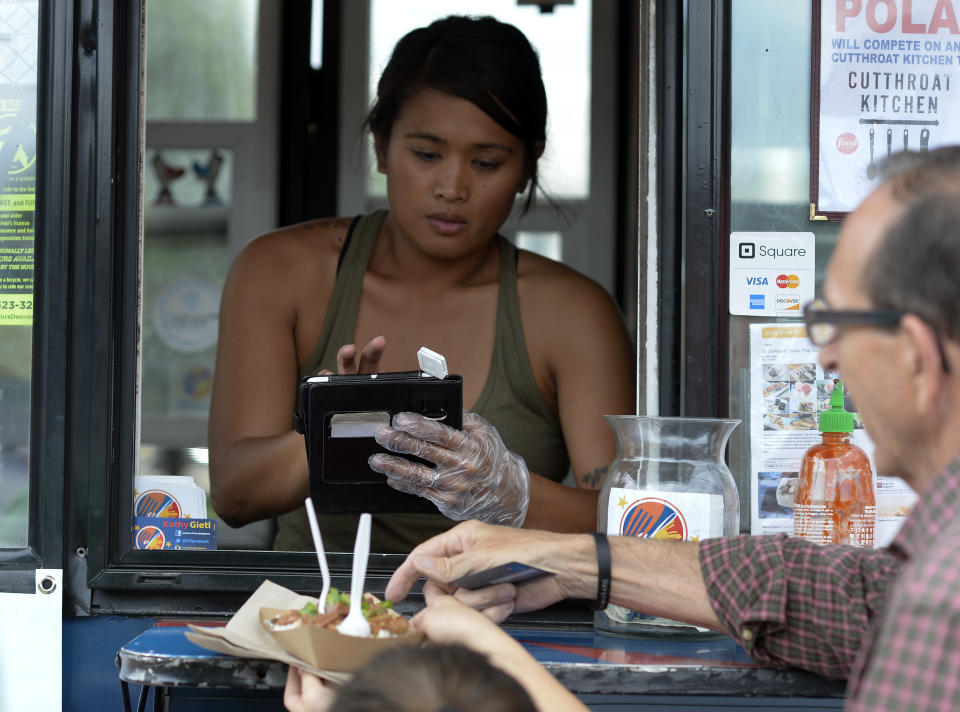
With Square, he continues, “people think the innovation is the swiper” — the card-reading dongle that attaches to the smartphone. But that’s wrong, he says. “The real insight was about who could take a card payment. Up until then a business had to have about $100,000 in revenue before it was worth going through the hullabaloo of getting a merchant account,” which is what credit card companies required before they’d let a business accept a card. The retailer had to pay for a credit rating, and the rating had to be a good one. Then the retailer had to guess whether a maze of opaque charges and fees would make sense for them in practice. Finally, they had to buy specialized hardware and sign multiyear contracts. Dorsey and McKelvey swept away all of that.
The swiper technology was secondary — a way to implement the insight. At first, Dorsey and McKelvey assumed that they’d have retailers photograph customers’ credit cards with their smartphone camera, and then use OCR — optical character recognition — to extract the information needed to process the payment.
In February 2009, McKelvey went to see Robert Morley, Jr., an electrical engineering professor he knew at Washington University, and told him what they were going to do.
“No, you aren’t,” Morley told him, according to an affidavit he later filed in federal court. “You’re going to read the mag[netic] stripe [on the card]. That’s what it’s there for.” They could do that, Morley explained, simply by designing a swiping device that would plug into the microphone jack. Morley built a prototype for McKelvey within 10 days. (A few months later, McKelvey gave Morley money to hire an attorney to patent the swiper. Morley got the patent, but listed himself as sole inventor. When Dorsey and Morley couldn’t agree on what Morley’s work was worth to the company, six years of litigation ensued. It was settled in 2016 for a confidential sum, but with Square taking a $50 million charge. By then, however, Morley’s patent had been invalidated, since, it turned out, someone else had patented the idea before Morley. Morley did not return messages.)
To build the business they wanted, Dorsey and McKelvey needed to school themselves in the labyrinthine credit-card payments system. They met with Dorsey’s old friend Kidd, who knew the regulatory side of it from his years in the payments division at the Federal Reserve. Then they sought advice from Ryan Gilbert, a lawyer and financial services entrepreneur who knew the field from a business perspective.
Also in February 2009, just 10 days after first contacting Morley, the budding company brought in software designer Robert Andersen, who had once worked for Apple. Andersen, it happens, was the Twitter user Dorsey credits with having first used the @ symbol to direct a tweet to a particular person (Andersen’s brother), drawing on a convention from Internet Relay Chat.
“He’s one of the crown jewels of the company,” Gilbert says of Andersen. “[Dorsey and he] share a design ethic for what is beautiful and functional.” A decade later, Andersen, who, like Dorsey, never graduated from college, is Square’s creative director.
Originally, the founders planned to call the company Squirrel, as in “squirreling away.” They had some early swipers crafted in the shape of acorns. But they soon found out that there was already a payments company called Squirrel in Canada. Dorsey combed through the dictionary, settling on Square. He liked its positive associations with payments, he told Kara Swisher in 2011, as in “square up” and “fair and square,” and it would be cheaper to build a square swiper than an acorn-shaped one.
The founders planned to give away both the swiper and app for free to customers — small retailers like taco trucks, coffee shops, flower cart operations. They would then charge a low flat-fee for each payment processed, eventually set at 2.75%. (That’s low for the industry, and a portion of that goes to the card companies, banks, and other intermediaries.) They would forego any credit check. Dorsey has said that, at the time, he was himself in massive credit-card debt — either $250,000 or $400,000, according to different interviews. Though he was rich on paper from cofounding Twitter, his wealth was locked in equity.
The nub was the merchant account. The small-time retailers they wanted to serve could never afford their own. But perhaps Square could persuade the card companies to let Square get a master account, while its customers piggybacked onto that.
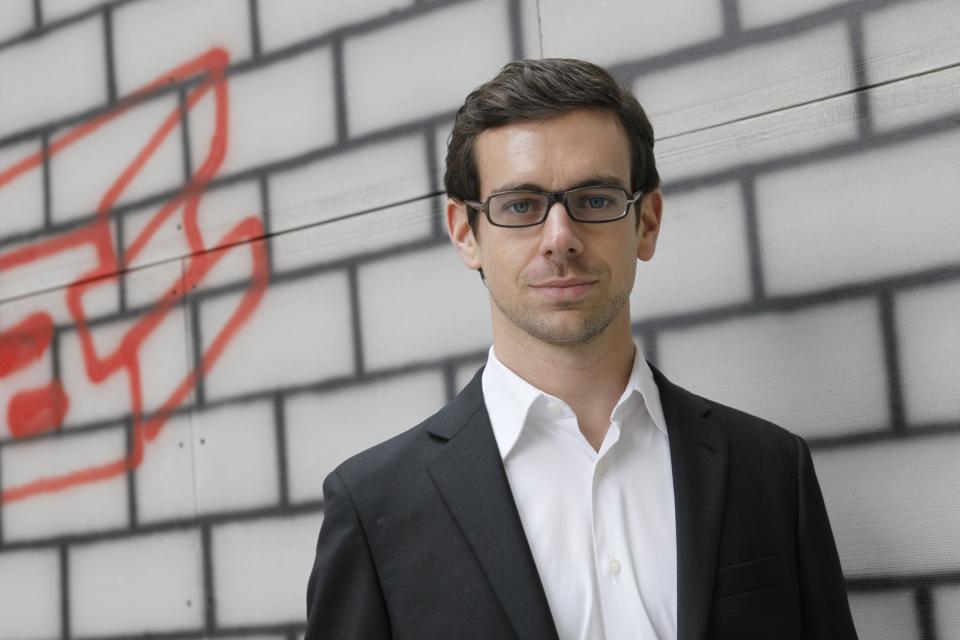
PayPal had done something like that before, Kidd explains, but for online payments only. (Square’s first chief operating officer, hired in August 2010, would be Keith Rabois — a top official at PayPal when it was getting started.) This was the first time someone was trying to do it for brick-and-mortar merchants. At the time, online payments accounted for only about 4% of the market, Kidd says. So that left Dorsey and McKelvey a huge opportunity.
The opportunity was actually even bigger than that. The swiper product was just a wedge into a whole industry. Eventually they’d be providing a range of services for an underserved community: small businesses, like the coffee shop Marcia Dorsey used to run.
It all began with the receipt.
“Jack was the first to see that the receipt was actually a source of competitive advantage,” Kidd says. A digital receipt, emailed or messaged to the customer, could provide more useful information to buyers with a more attractive design. “You didn’t have to be limited to what you can print out on a spool of paper from a crummy little, low-cost, proprietary piece of hardware.”
In the digital receipt, the merchant could include his “twitter handle, his Facebook page, Yelp account, menu, hours — whatever they want to put there,” Dorsey explained at the Stanford eCorner talk in 2011. The receipt became a “publishing medium” instead of a scrap of people quickly tossed in the trash, he said.
More important still was the data summarized in the receipt. Square would be collecting that. With it, Square could provide customers with an analysis of their businesses the way “Google Analytics” did for website operators, Dorsey explained at the Stanford talk. “How many cappuccinos did you sell today? . . . How many bought biscottis? … Offline merchants have none of this data.”
In fact, Square would eventually have so much information about its customers that it could offer them unsolicited loans of, say, $1,000 to $10,000. These would be meaningful sums to small business people, but too trivial for banks to bother with. (Square Capital would begin doing that in 2014.)
Dorsey and McKelvey were creating a closed-loop ecosystem for small businesses. From initially giving away swipers, they would move on to offering sleek, standalone payment terminals and also virtual cash registers (gorgeous apps that run on iPads) that act as comprehensive point-of-sale systems, assisting businesses with payroll, accounting, inventory, and more. As their customers grew, Square would grow with them, adding services for ever larger businesses, elbowing its way ever deeper into the financial services industry.
In the years to come, all of this came to fruition. This past February, CEO Jamie Dimon, speaking at a J.P. Morgan Chase Investor Day, looked back wistfully at all Square had accomplished.
He lamented, according to American Banker: “They did all this stuff we could have done that we didn’t do.”
In September 2009, with Square in gestation and Dorsey the titular chairman of Twitter, Dorsey came home to St. Louis, a local boy made good. He had been invited to throw out the ceremonial first pitch before a St. Louis Cardinals game. Characteristically, he gave considerable thought to the image he would convey, according to St. Louis Dispatch accounts of the time. At first, he bought a Bob Gibson jersey to wear. Though before Dorsey’s time, Gibson was his favorite player. But then Dorsey’s father, Tim, surprised him by presenting him with a genuine, grey, Cardinals away-game jersey from the Gibson era, which Tim had unearthed from storage. According to the paper, Tim had once done the Cardinals’ laundry. (Tim did not return a message.) Then, the night before the game, Dorsey practiced pitching for nearly three hours at a lighted, local, sandlot field. He wanted to make sure he didn’t throw the ball in the dirt.
In the end, his pitch sailed well wide of the plate. But it didn’t bounce, and the nimble catcher, Joe Thurston, was able to snare it, according to the sports page. McKelvey later made fun of Dorsey all the same. “He threw out the first pitch at the Cardinals game wearing Prada shoes,” he told Mashable.
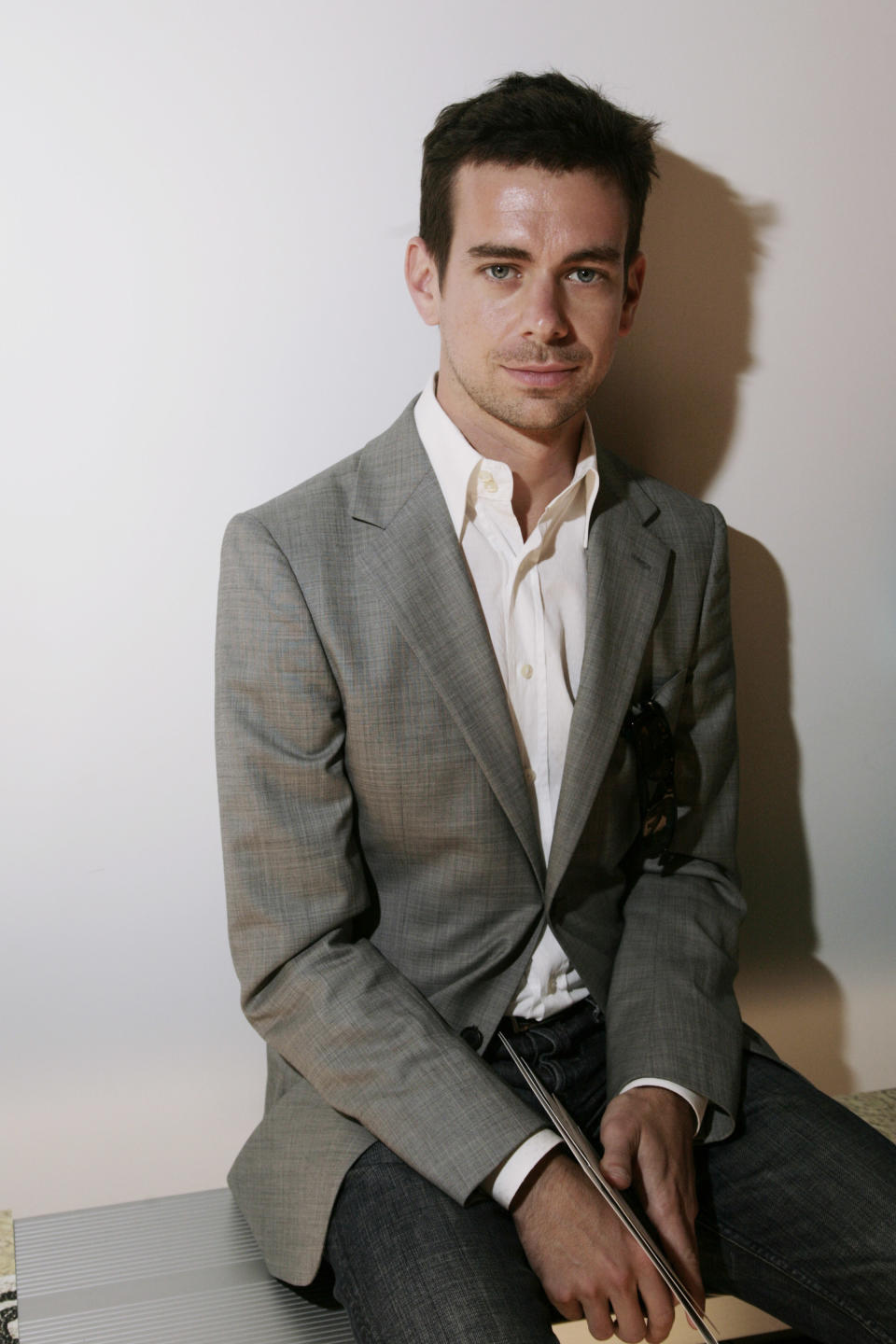
Indeed, as Square was launching, Dorsey was going through a Prada stage. He also passed through a period in which he seemed to be consciously emulating Steve Jobs — in fashion, diction, and even musical tastes — according to Bilton, who savagely mocked him for it in “Hatching Twitter.” (Still, the substantive parallels with Jobs are striking and undeniable. Jobs, too, was ousted from the first company he founded [Apple]; audaciously created another [NeXT]; then returned in triumph to his original company as interim and, later, permanent CEO; and, finally, came to simultaneously lead a second mammoth company (Pixar). Jobs, like Dorsey, also saw beautiful design as critical to his products.)
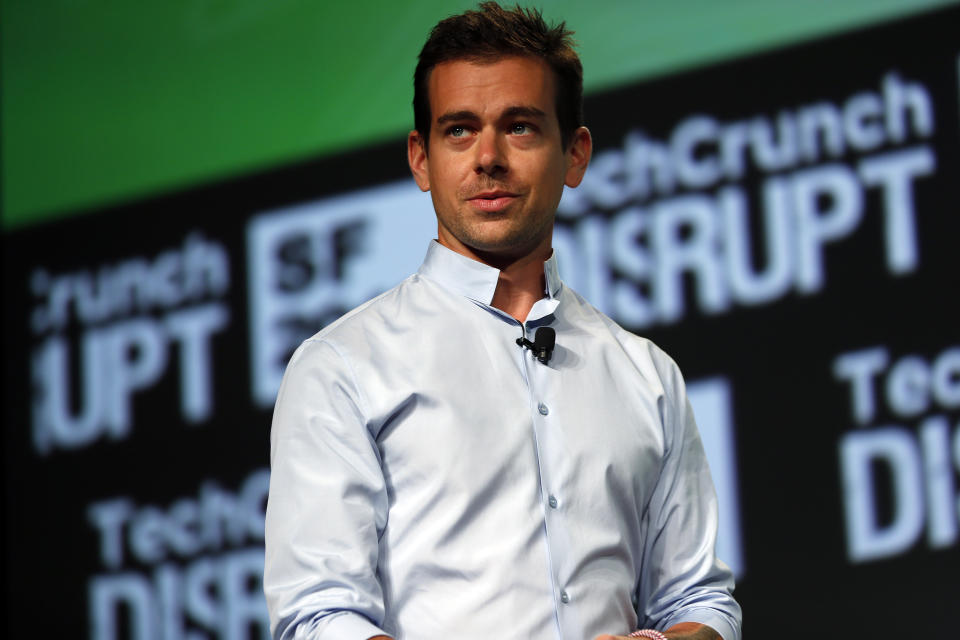
By 2012 Dorsey was often wearing an odd style of shirt that GQ has identified as a Dior Homme “reverse collar.” Tellingly, Dorsey himself described the style to the Wall Street Journal that year as “halfway between a Nehru and a priest’s collar.”
By late 2012 he had discovered Rick Owens, and was smitten. “So impressed by Rick Owens,” he tweeted that October. “Straightforward, dark, cool. Stunningly unique.” Owens’s style has been described as “dude Goth.”
A year later Dorsey tweeted out an article by Owens in Harper’s Bazaar. In it, Owens wrote, “I’ve worn the same black outfit for years, like a priest.”
Beginning about two years ago, Dorsey, too, began to wear all black. In his Q&As, he typically explains that development as an adaptation to his decision, in mid-2016, to start each day with a brisk, five-mile walk to work from his house in the Sea Cliff neighborhood of San Francisco. Black clothing hides the perspiration stains from the walk, he has said. (Dorsey bought the Sea Cliff house for a reported $10 million in 2012. This past June he reportedly bought the property next door, for $22 million.)
Since about the end of 2014, Dorsey has been gradually letting his previously close-cropped chin and moustache hair grow out into a full, Nazarene beard. Over the past year he has often added a black beanie, which imparts a religious aura, like a skullcap or a monk’s cowl.
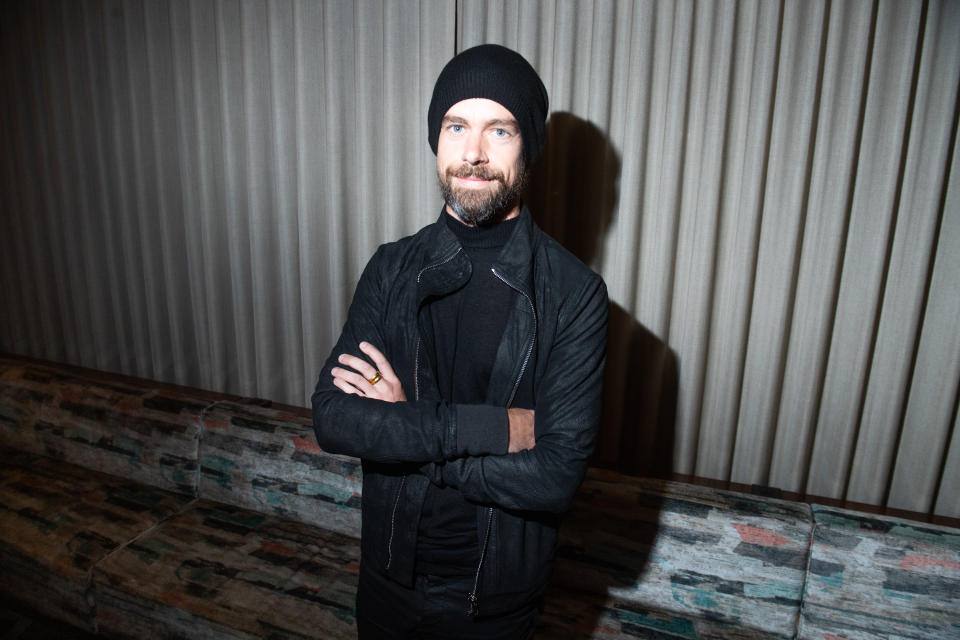
When he takes his morning fast-walk to the office, he likes to wear running sandals. They are a modern-day riff on the huaraches that the indigenous Tarahumara people of Mexico have long worn when running, he told Roll. Such sandals are characterized by a long, thong-like strap that leads from the big toe to the ankle.
“Last time I saw [Dorsey], he had on sandals,” said entrepreneur-philanthropist John Hope Bryant, while introducing Dorsey at the Hope Global Forum last May. “Looked like Jesus!” he joked.
Well, yes. He does.
A very different leader at Twitter and Square
From 2011 to 2013, while Square was getting up and running, Dorsey cooperated in a series of profiles that publicized the new company. Among others, he spoke to Vanity Fair (Kirkpatrick), Forbes (Eric Savitz), “60 Minutes” (Lara Logan), and The New Yorker (Max). Each prominently featured his claim that he was considering running for mayor of New York — his “dream job,” as he told Kirkpatrick.
The aspiration appears to have abruptly vanished by the end of 2013. (Asked about running for mayor this past June, during a Q&A in London, he joked: “I’d have to change my outfit, and I wouldn’t want to do that.”)
The Bilton book, “Hatching Twitter,” came out in the fall of 2013. While the profiles of the preceding two years had been favorable, the book contained sharply off-message passages for both Dorsey and Twitter. Bilton depicted Dorsey as a shrewd, behind-the-scenes corporate in-fighter, and someone who could be quite two-faced. Regarding early Twitter colleague Noah Glass, Dorsey had precipitated his firing in 2006, Bilton wrote, by telling Odeo CEO Williams, “It’s him or me.” The night after Williams fired Glass to keep Dorsey happy, Dorsey went out drinking with Glass, commiserating with him and consoling him, without mentioning his role, according to Bilton. (To the New Yorker’s Max, Dorsey denied having made any “him or me” ultimatum to Williams, but admitted having said, “I don’t think I can work with [Glass] in his current state.”)
Twitter and Square are very different companies. As a consequence, employees who have worked at each react to Dorsey in very different ways. Though the boss they describe is recognizably the same guy, the Square people are more apt to laugh off his eccentricities.
Square alums also stress how inspiring he can be. “He was very good at communicating the vision,” says one. “He can be compelling both one-on-one and with larger audiences."
“He’s very authentic,” says another. “Everyone feels like they’re doing their life’s work.” It’s an all-the-more impressive accomplishment, this person notes, because, “I mean, it’s a credit-card processing company.”
Square’s employees and investors have always known what the company was. Square had revenue and a business model from day one. It never suffered from cofounder sniping or board putsches.
Twitter is a totally different animal. It had no revenue for three years, its business model remained a puzzle for long after that, and its executive instability persisted for almost a decade. Worse still, there was longstanding confusion about its fundamental identity. What was it, exactly?
The prodigal founder returns
The musical chairs at the top resumed in October 2010. The board ousted Williams as CEO, replacing him with Dick Costolo — Twitter’s third CEO in the four years of its existence. In March 2011, Dorsey returned to the company as executive chairman, overseeing product and, initially, marketing, too. (According to Bilton’s book, “Hatching Twitter,” Dorsey’s return was engineered by Peter Fenton, who invested in Twitter and became a board member in early 2009, after Dorsey’s ouster as CEO. Not having even understood Dorsey’s exiled status when he bought into the company, Fenton met with him and took his side. Then, with Dorsey’s behind-the-scenes assistance, Fenton fought to restore him to an executive role, according to Bilton’s account. Fenton did not return messages.)
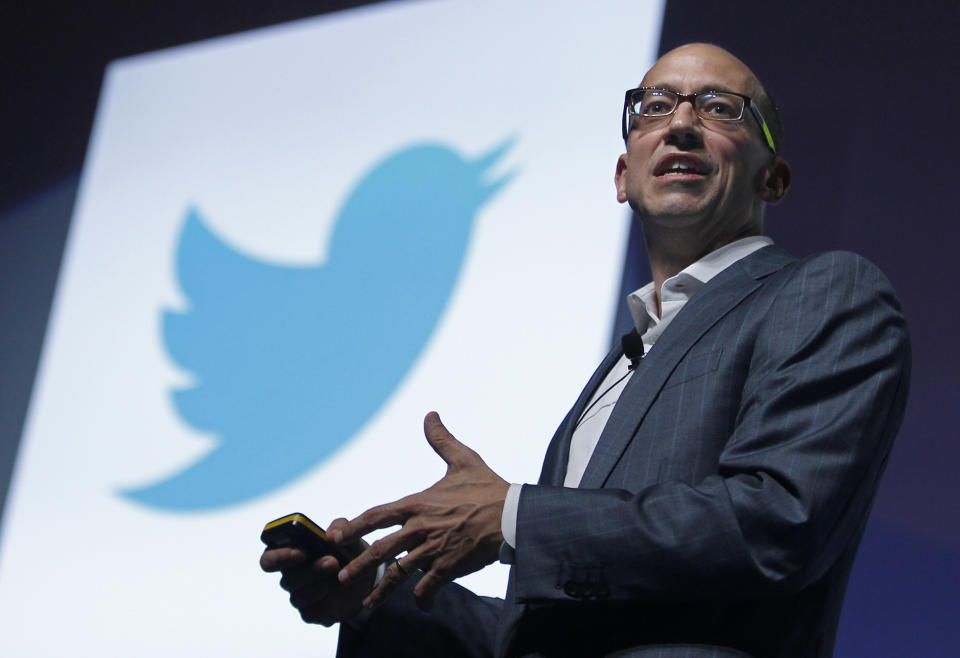
For about a year after his return, Dorsey worked madly — at least eight hours at each company every day, he told both Kara Swisher and Techonomy’s Kirkpatrick. (A Square staffer of the time confirms that he was working crazy hours, and believes that Dorsey’s estimates are plausible.)
But by mid-June 2012, Dorsey’s role was changing again. He was dialing down his presence at Twitter — eventually to about once a week — and was devoting most of his time to Square again, according to two former Twitter staffers and contemporary media accounts. During this period, Twitter began churning through chief product officers at a rate that has become legendary.
In July 2015, with Twitter’s stock price having fallen to the mid-$30 range — less than half its peak — Costolo was pushed out. The board named Dorsey interim CEO. It initially ruled out giving him the permanent title, specifying that it would only hire someone who could devote himself single-mindedly to the company. Three months later, though, with shares having dipped still further — below the IPO price of $26 — the board reversed course, naming Dorsey to his second stint as Twitter’s CEO, notwithstanding that he was Square’s CEO, too.
One Twitter staffer of the time remembers Dorsey having made a concerted effort to win over employees during his period as interim CEO. Dorsey would have dinner with the leads and brainstorm with them, this person recounts. When the board asked staffers what they thought, many recommended giving Dorsey the nod, he recalls, including himself. The board did so.
“Almost immediately, it switched,” the staffer says, and Dorsey was off “in his cave again. I felt a little like I’d been had.”
Three months after Dorsey became permanent CEO, four high officials quit en masse, including high officials in product, human resources, engineering, and communications.
Then came the takeover rumors, which persisted through most of 2016. Google, Apple, Disney (DIS), and Salesforce (CRM) all reportedly took a look, but then passed. (Yahoo and Facebook had each courted Twitter much earlier — in 2007 and 2008 — but Twitter had rebuffed their advances.)
In addition to being plagued by managerial instability, Twitter was beset by identity crises. “The core dysfunction,” says one former Twitter official, “was the company never having defined what it was.”
From the moment of its founding, there had been a split over whether Twitter was fundamentally about personal status updates, as Dorsey originally envisioned it, or was really about newsier and weightier bulletins.
Dorsey initially saw the platform in a way that is surprisingly similar to how it is often caricatured by those who disdain it: as a site where narcissists tell each other what they had for breakfast. Dorsey has often defended the value of Twitter when used in this fashion. He has explained that a tweet about what he had for breakfast was meaningful to his mother, because it reassured her that he was alive and well. (This was, of course, back when he still ate breakfasts.) Asked in 2008 by the MIT Technology Review whether such tweets weren’t “trivial,” he parried, “There's a universe in the smallest, most ‘trivial’ details of one's life.”
But others at Twitter, including Ev Williams, disagreed. When Williams took over he changed Twitter’s prompt from “What are you doing?” to the more topical “What’s happening?” which is still used today.
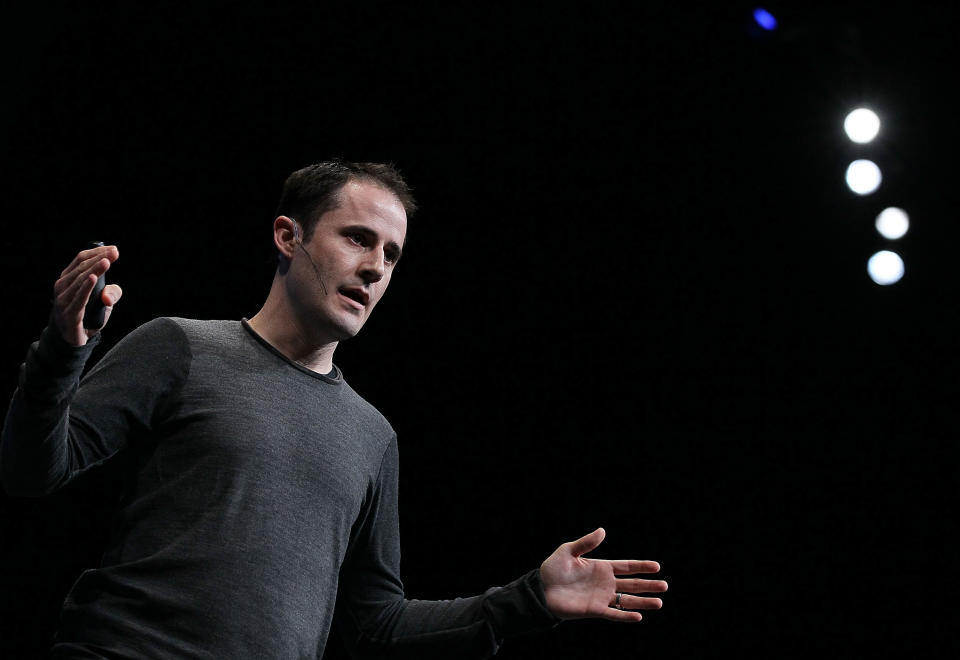
As the service grew, more important identity crises arose. The biggest: Was Twitter a social media network or was it a media/news service?
‘The wrong leader’ for Twitter
When Twitter went public in November 2013, many investors assumed it was a social media site that would grow like Facebook and offer similar advertising prospects. Some at Twitter had encouraged this view. In 2012, for instance, a product officer there publicly predicted that the platform would eventually have 2 billion monthly active users. Though the company’s IPO price was set at $26, bullish traders drove it up to $41 by the end of the first day, and the price reached almost $70 just two months later. But that turned out to be its all-time peak.
It soon became apparent that Twitter’s user numbers were not remotely keeping pace with Facebook’s. (They leveled off at about 330 million monthly average users worldwide before Twitter stopped reporting the figure altogether earlier this year.)
Twitter shares got a brief bump after Dorsey was named CEO in October 2015, but then resumed their downward trajectory, dipping to almost $14 by April 2016.
That month Twitter instructed Apple’s App Store to switch the Twitter app from the “Social Networking” group to the “News” category. (It later did the same with its Android app in Google Play.) One former Twitter staffer saw the move as a salutary turning point for the company, with Twitter finally settling on its identity. Another, however, saw the move as more tactical and even face-saving. Twitter ranked a mediocre fifth among social media apps, but would rank first among news apps. The higher ranking made it more likely that someone browsing the App Store would download it.
Amid all this existential uncertainty about what Twitter was, several Twitter veterans who spoke to me found Dorsey’s hands-off style inadequate to the tasks at hand.
“Jack is remarkable in many ways,” says one, “but he was frustratingly the wrong leader in an environment like that. He does not provide concrete direction.”
Another former Twitter official — who acknowledges that he’s probably “more anti-Jack than the average person” — felt there was too much “hand-wringing” and “discussion,” and too little action. “[Dorsey] cultivates this super-genius image,” says this person, “but I think a lot of it is hollow. … Not everything should be life advice. Sometimes you need to address known tradeoffs and actually decide and do something.”
One person thought the company’s mishandling of an acquisition was illustrative. In October 2012, Twitter bought the startup Vine for a reported $30 million, with Dorsey being the liaison between the company and Vine’s founders. The startup, which went live in January 2013, allowed users to make six-second loop-videos on their phones, creating a new art-form.
“Jack saw that it was something pretty magical, and how it could be complementary,” recalls the former staffer. The problem, he feels, was that Dorsey let the founders keep working on it from New York, and let them keep Vine’s identity separate, rather than incorporating it into Twitter. It took four months for Vine to develop a version that worked with a selfie-facing camera, and six months to launch an Android version. By then, however — June 2013 — Instagram was coming out with its own short-video app (with 15-second loops). That soon blew past Vine in popularity. Twitter began phasing Vine out in October 2016 and shut it down in January 2017.
“We were competing against Facebook/Instagram — a super high-functioning company,” says this former Twitter employee. He imagines Instagram saying: “Great, Twitter. Thank you for validating the proof of concept … and then not doing anything with it for basically a half year. More than enough time for us to catch up.” (Twitter, on Dorsey’s behalf, declined comment.)
Dorsey’s mysterious, hands-off approach to Twitter left another ex-staffer there with an unsettling final impression. He ended up feeling that Square was Dorsey’s commercial business, while Twitter was something else.
“He sees Twitter as a social good, to advance humanity overall,” this person says. “It’s almost philanthropic.”
Twitter’s current turnaround springs from the company’s having found ways to make money without chasing Facebook-levels of user growth. By mid-2016, Dorsey was publicly reducing expectations. “I don’t know that the race for users is the right race for us,” he told Peter Kafka at a Recode conference.
The last quarter of 2017 — nearly 11 years after launch — was its first profitable one. Yet it has remained in the black every quarter since then. (It has had considerable success with video advertising and with premium video partnerships struck with, for instance, sports and news groups, like the NBA, NFL, ESPN, and the Wall Street Journal.)
Dorsey has found strong managers for both his companies, and leans on them heavily. The Twitter people who spoke to me particularly praised the contributions of former COO Adam Bain (who left in late 2016) and former CFO Anthony Noto (who left last year).
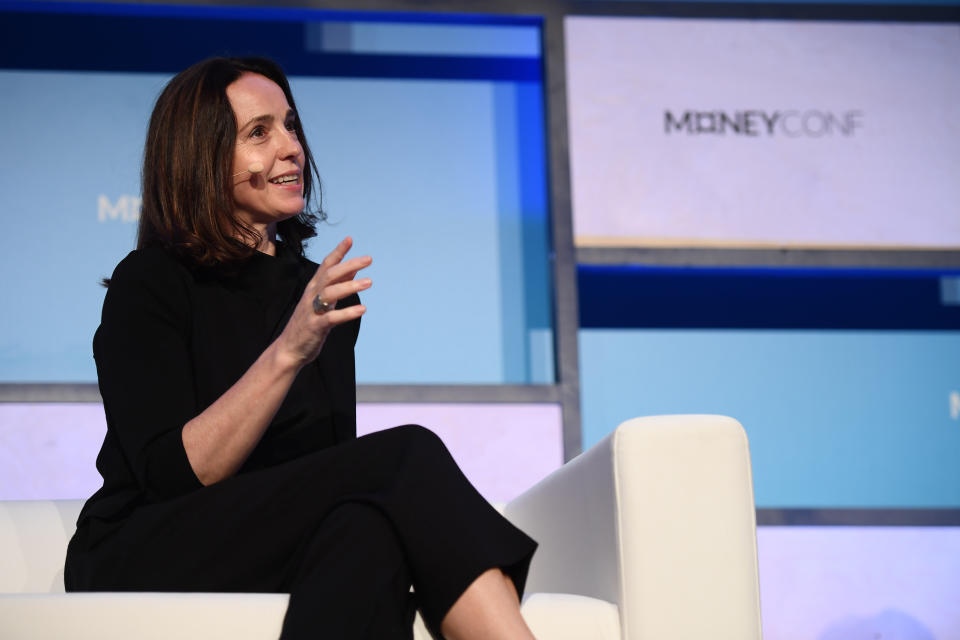
Investors understand the unusual degree to which Dorsey relies on his managers. At Square, when its highly regarded CFO, Sarah Friar, stepped down last October, shares fell almost 11% — the sort of shellacking more often associated with a CEO departure. (The stock had already been falling, though, due to some negative analyst sentiment.)
Kidd — Dorsey’s longtime friend and champion — thinks that having Dorsey rely so heavily on his managers is sensible under the circumstances. “I’m not looking to Jack to manage,” he says. “Jack wasn’t built to be a manager. Jack’s built to be a leader.”
‘He’s never stepping down’
Will Dorsey ever cede the reins of at least one of these companies to one of his capable managers? One former Square staffer expresses surprise that he hasn’t already, given his stage of life, level of success — his net worth is estimated at more than $5 billion — and the toll his hours take on his life. (He accepts only $1.40 per year in compensation from Twitter, and $2.75 per annum from Square. These figures allude, respectively, to Twitter’s original 140-character limit and to Square’s 2.75% fee on credit-card payments.)
“He’s truly devoted to both those companies to an absurd degree,” this person says. “I [had] personally believed he would go to an ashram, write poetry, go off the grid.”
This source wonders if Dorsey’s 2008 ouster as Twitter CEO has something to do with his refusal to cut back his roles. Maybe Dorsey feels — irrationally — like he still has something to prove, the Square alum speculates: “If you go through a breakup and you get back together again, you still remember the breakup. The relationship is never quite the same.”
(Dorsey has said that one reason he can devote so many hours to his companies is that he has never married. He has had girlfriends over the years, reportedly including ballerina Sofiane Sylve and, for several years, entrepreneur Kate Greer. “I do want to have family at some point,” he told Greenfield in March.)
There’s another reason Dorsey might not walk away from either company soon, according to a different ex-Square employee.
“So much of [Dorsey’s] identity is invested in being Steve Jobs. In being Elon Musk. In running two companies,” this person says. “He’s never stepping down. If you think he is then you don’t know Jack Dorsey.”
So, for the foreseeable future, it appears that the fate of investors in Square and Twitter will continue to rest in the hands of Jack Dorsey. Which is probably as it should be.
What’s harder to accept is that our fate rests in his hands, too — We, the People, that is, who feel privileged to live in a Western democracy and would like to continue doing so. That part is more worrisome.
Read more
Jack Dorsey’s love of bitcoin could be a problem for Square
Exclusive: Facebook ex-security chief: How ‘hypertargeting’ threatens democracy
Roger Parloff is a regular contributor to both Yahoo Finance and Newsweek, and has also been published in Yahoo News, The New York Times, ProPublica, New York Magazine, and NewYorker.com, among others. He was formerly an editor-at-large at Fortune Magazine.
